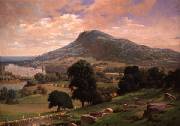ABSTRACT:In this lab, students examine tree communities found on the north and south slopes of a local mountain (in the Holyoke Range, near Amherst, MA). Student-generated questions include: are the tree species different on the two slopes? are there density and size differences? are these differences due to climate and adaptation to cold and drought? are there other important factors that help us understand the types and sizes of trees that we find there? CLASS TIME:MULTIWEEK - four three-hour lab periods (2 for field trips, 2 for data analysis). OUTSIDE OF CLASS TIME:4-12 hours needed for students to finish their research papers. STUDENT PRODUCTS:Students are assessed based on their individual research paper based on student-collected data. SETTING:Field data collection in two different habitat types (any season), with data analysis in lab. COURSE CONTEXT:Undergraduate freshmen and sophomore-level course in Ecology, about 20 students. INSTITUTION:private undergraduate college. TRANSFERABILITY:This activity would be amenable to any field situation where contrasting environments and communities of organisms exist in close proximity (e.g. for vegetation in dry/wet fields, young/older forest, grazed/ungrazed or mowed/unmowed fields, polluted/less polluted wetlands; see Description section for links). It could be used in basic ecology, plant ecology, or community ecology courses. AUTHOR:Charlene D'Avanzo, School of Natural Sciences, Hampshire College, Amherst, MA, 01002, cdavanzo@hampshire.edu |

View of Mount Holyoke, by John Gue, circa 1900, courtesy of Mount Holyoke College Art Museum
[full size image] |